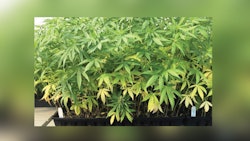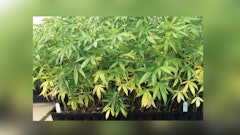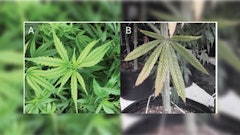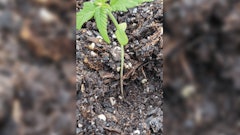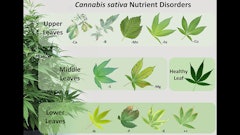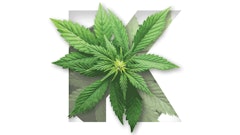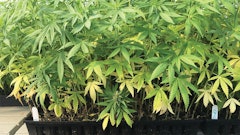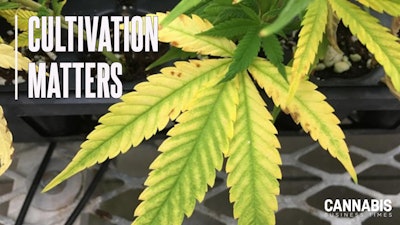
Correctly identifying the deficient nutrient ensures appropriate management and prevents unnecessary or ineffective treatments. But nutrient deficiencies in plants often present symptoms that closely resemble one another, and many also share visual similarities, making accurate diagnosis challenging.
As such, it’s crucial to observe where on the plant symptoms first appear—whether on older, middle, or younger leaves. This location provides vital clues, as different nutrients are mobile to varying degrees within the plant.
How Nutrients Move
In general, nutrients can be divided into two categories: mobile and immobile. Mobile nutrients such as nitrogen (N), phosphorus (P), potassium (K), and magnesium (Mg) can be translocated from the lower foliage to the new developing growth when nutrient demands exceed what the plant can uptake (Fig. 1).
Immobile nutrients include iron (Fe), manganese (Mn), calcium (Ca), boron (B), zinc (Zn), copper (Cu), and molybdenum (Mo). Immobile elements cannot be translocated throughout the plant to satisfy the demands of new growth (Fig. 1). When assessing visual nutrient deficiencies, utilizing the location of the visual symptoms is important in identifying the problem.
For example, interveinal chlorosis is observed when the leaf tissue between the veins turns yellow while the veins remain green, creating a distinct pattern (Fig. 2). This symptom is commonly associated with deficiencies in nutrients like Mg, Fe, or Mn.
Mg is a mobile element, and the interveinal chlorosis will first be observed on the lower older foliage and progress to the middle portions of the plant (Fig. 3). On the other hand, Fe deficiency will first be observed in the new growth and on the developing foliage (Fig. 4).
Considerations to Aid in Visual Diagnostics
There are a variety of considerations that can also help confirm visual diagnostics. Fe deficiency can be a result of a variety of factors, such as oversaturated media, high pH (>6.5), or nutrient antagonism. Fe is included in most fertilizers that include a micronutrient package and, as a result, is generally supplied in sufficient amounts.
Mg can be supplied to the plant in a variety of ways, including dolomitic limestone as a preplant charge, through the irrigation water, or through the fertilizer. Testing the irrigation water is important to determine what elements are included naturally and what elements must be supplemented.
In areas with low alkalinity in the water during high-growth demand periods, such as floral development, Mg deficiency can be observed. Additionally, not all fertilizers include Mg. For growers with insufficient Mg in their water, utilizing a calcium-magnesium (Cal-Mag) supplement or supplying Mg from Epsom salts or an Mg nitrate fertilizer is important to avoid late-season nutrient deficiencies once the Mg from dolomitic lime is no longer available.
Additionally, taking leaf tissue samples can be a very useful tool. From previous literature, adequate Fe should be between 59–169 parts per million (ppm) of the leaf, and Mg should be within 0.25%–0.81% for vegetative plants (Kalinowski et al., 2020). While these values will vary slightly based on cultivars and growing conditions, they can be a good range to start with.
Conclusion
Accurate identification of nutrient deficiencies is critical for effective plant management, and understanding the mobility of nutrients like Mg and Fe is key to diagnosing issues based on symptom location. While both elements are essential for healthy growth, their differing mobility within the plant results in distinct visual patterns that can guide growers toward more precise solutions.
By combining visual observations with environmental assessments, fertilizer practices, and tissue testing, growers can make informed decisions to correct deficiencies early, prevent future issues, and support optimal plant performance throughout the growing cycle.
Kalinowski, J., Edminsten, K., Davis, J., McGinnis, M., Hicks, K., Cockson, P., Veazie, P. and Whipker, B. 2020. Augmenting nutrient acquisition ranges of greenhouse grown CBD (Cannabidiol) hemp (Cannabis sativa) cultivars. Horticulturae 2020, 6(4), 98; https://doi.org/10.3390/horticulturae6040098
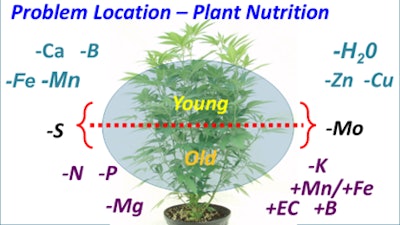
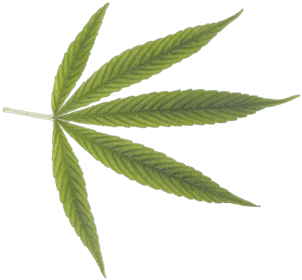
 Photo by Brian Whipker
Photo by Brian Whipker
 Photo by Brian Whipker
Photo by Brian Whipker











